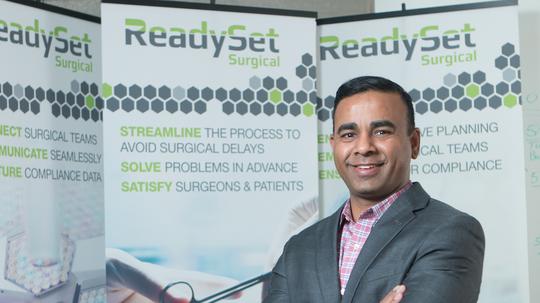
It is estimated that five- to six billion dollars are wasted in American hospitals each year.
It's due to issues with "vendor-managed inventory" that hospitals buy on consignment or borrow from surgical device companies, according to ReadySet Surgical founder and CEO Keerthi Kanubaddi.
He explained that hospitals keep items, such as surgical implants, on their shelves, and pay the medical device companies for them once they are used. However, Kanubaddi added that the vendor managed inventory is notorious for inefficiencies, such as parts expiring while they sit on shelves, items being thrown away because they were not sterilized properly and worst of all, items not being ready for patients when they need them. These inefficiencies can cause costly delays in the operating room.
“What we’ve done is made the entire supply chain DEPENDENT on the individual patient."
During his 12-year career as a surgical device and sales representative, Kanubaddi saw the need for software that connects hospitals with surgical device companies to help each entity oversee vendor-managed inventory. In the most severe instance he saw, the proper tools for a neurosurgery on a three-month-old were not available at the time of the procedure, due to a lack of communication between the hospital and surgical device company. As a result, the surgical team had to perform a different, more invasive type of surgery on the infant that resulted in a longer hospital stay and higher surgical cost.
Disgusted because of the situation, Kanubaddi designed the ReadySet Surgical software, quit his job and made the technology available for hospitals to try out in 2014.
The technology he developed is a cloud-based platform that allows hospitals and medical device companies to coordinate the vender-managed inventory needed for a procedure in real time. Surgeons simply choose the tools that they will need for a procedure, and ReadySet Surgical takes care of the rest; vendors track delivery, hospital staff verify sterilization, the use of the instruments is recorded and the hospital sends a payment for the device to the vendor.
“We believe we can save any hospital a seven-figure amount in a given year with the full suite of products,” Kanubaddi said. “Workflow is so critical right now, because the cost of operating rooms sitting idle is staggering. It is estimated at over $100 per minute for any delay in operating rooms.”
ReadySet Surgical now has 16 employees, eight of which work from Cincinnati. Over 100 hospitals use the platform, including Mercy Health, The Ohio State University Wexner Medical Center, Premier Health in Dayton and Dayton Children’s Hospital.
The growth of ReadySet Surgical was facilitated by all of the main regional funding groups for early stage companies. Kanubaddi said his company has great support from Ohio Third Frontier. He believes that ReadySet Surgical was able to secure the funding because the groups saw how much knowledge he gained about the problem from his former career and how passionate he is for creating a solution.
Kanubaddi said ReadySet Surgical plans to grow by continuing to make medicine as personalized to the patient as possible.
“What we’ve done is made the entire supply chain dependent on the individual patient,” he said. “We can create a specific supply chain for that patient, and over time that will allow us to get more personalized with the medicine.”
For example, Kanubaddi said a lot of the waste in health care exists because of the way hospitals purchase things. Hospitals may buy inventory in bulk without understanding exactly how it is going to be used. Kanubaddi envisions ReadySet Surgical helping hospitals cut even more costs by making the platform specific to each patient.
One of ReadySet Surgical’s additional expectations for the future is to be able to share images of a patient’s diagnostics. While the ordering of devices for procedures is usually very fragmented, hospitals will be able to send a notification to the device company that the patient is scheduled for a procedure and show them their diagnostics. This will facilitate things such as ordering devices that will work best for that patient and even 3D printing implants that are exactly matched to the patient’s anatomy.
“I think you really are able to accomplish two great things at once,” Kanubaddi said. “Who doesn’t want something that is very specific and personalized to them, and who doesn’t want to save money in that process? Technology is at a point where we can all plan for patient procedures and be totally ready."








